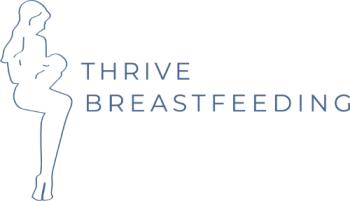Engorgement is one of the most common breastfeeding challenges in the early days of postpartum. What does it mean to be engorged? And how do you best relieve engorgement? Bookmark my blog post to learn common breastfeeding terms that every mom should know. Today’s topic: engorgement symptoms and treatment so that you can find relief with ease!
During my 10 years as an IBCLC, hundreds of families have found relief following these recommendations. I hope you find this advice as helpful as my clients do!
Engorgement Symptoms
The most common sign of engorgement is uncomfortable breast tightness. Your breasts feel so full – often rock hard – that it’s painful. Engorgement isn’t necessarily a bad thing as it’s often a sign of a healthy milk supply to nourish your newborn baby. However, it can certainly make the start of breastfeeding a challenge.
How to Best Relieve Engorgement
Relieving engorgement is pretty straightforward. Simply breastfeed your baby with the correct latch technique, and do so often! Following the right treatment plan typically leads to relief in one to two days.
Steps For Engorgement Relief
- Bring baby to breast often – every 2 to 3 hours
- Before feeding, use warm compresses to help with milk flow. Then in between feedings, switch to cool compresses. Exposure to cold constricts blood flow and reduces engorgement.
- Avoid formula so that baby comes to breast hungry and nurses with gusto. Skipping a nursing session can make matters worse
- Wear a bra for support if it makes you more comfortable. Choose one without an underwire, as it can cause plugged ducts
- Take ibuprofen (Advil, Motrin) or acetaminophen (Tylenol) if needed
- If the baby is unable to latch and you need help emptying the breast, try hand expression.
Trouble Latching On Engorged Breasts?
Try these tips immediately before a nursing session:
- Before putting the baby to breast, hand-express a small amount of milk. This will soften the areola – the dark, round area surrounding your nipple – and help your baby latch correctly. If it’s difficult to hand-express, use a breast pump on low suction for 2 – 3 minutes to remove some milk
- Heat helps get milk flowing. Apply a warm wet towel or a hot pack for 5 minutes before nursing. Or simply do your best to get your breasts in the stream of a hot shower. Then cold compresses after or in between feedings to help with swelling
- Do you feel a small knot or lump in your breasts? Keep an eye out for clogged ducts as they can lead to mastitis. To help prevent infection, keep the milk flowing by gently massaging your breast when nursing or pumping
If Engorgement Doesn’t Improve
With these tips and tricks, you should start to see improvement within 24 hours. If you experience significant pain or extended periods of engorgement, it is most likely a sign that your baby isn’t nursing well.
CLICK HERE to get your FREE your step-by-step guide to learn latch & positioning techniques for pain-free breastfeeding.
